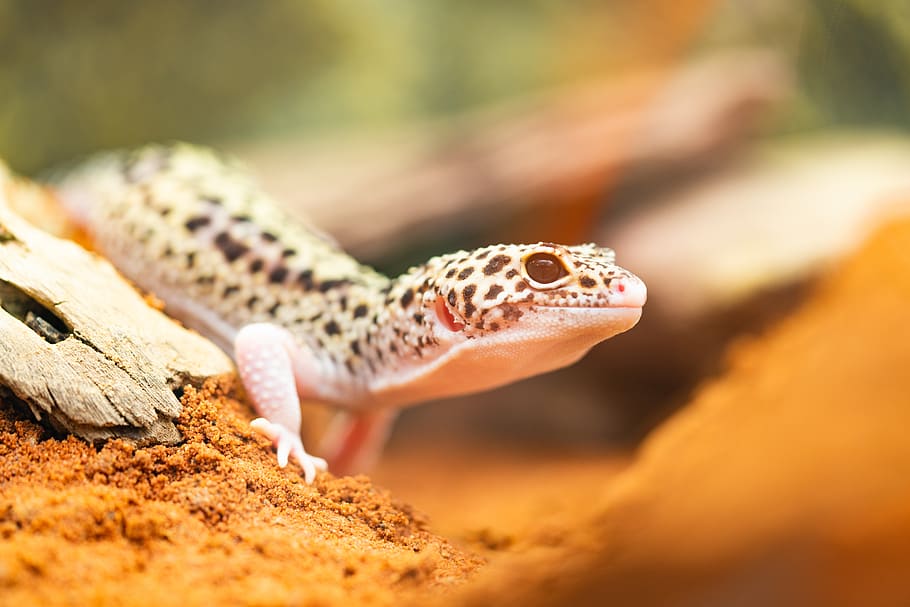The leopard gecko is one of the most popular beginner’s reptile. This type of gecko is a small lizard, comes in different colors, and it is easily handled because they are small. Usually, leopard geckos are white in color, and it is spotted with black dots. The leopard gecko’s hatchlings usually start with striped colors, and they slowly change into having a spotted appearance. Leopard geckos can be a nice pet, especially if you’re starting out to take care of reptiles just like them. In this article, we are going to help you get to know leopard geckos a little better.
- Common Name: Leopard gecko
- Scientific Name: Eublepharis macularius
- Adult Size: About 8 to 10 inches from their tails
- Life Expectancy: Leopard geckos in captivity can live up to 20 or more years.
Leopard Gecko Behavior and Temperament
Leopard geckos are ground-dwelling and nocturnal creatures that docile and easy to tame. Unlike other geckos, leopard geckos do not have any sticky toe pads, which is why you will never see them climb walls. And unlike many types of geckos, the leopard geckos have eyelids. This reptile is not prone to biting, and most of the time, they move slow. Aside from that, they have possessed perky personalities, and research shows that they can be vocal, more specifically when they are hungry. If you have at least one leopard gecko in an enclosure, you should watch out for tail-waving. This gesture means that a leopard gecko feels threatened, and they are ready to attack anytime. This is why you might want to separate them from the start. Just like rattlesnakes, leopard geckos are also tail rattlers. Tail rattling means that they are thinking of eating, mating, or they are just merely excited. Just like any other lizard types, Leopard geckos have the tendency to amputate their tails as a form of defense mechanism. However, they would rarely show this trait while they are in captivity. Still, it is one of the quirky behaviors that a leopard gecko does.
Housing the Leopard Gecko
If you are looking to take care of two to three leopard gecko, a 15- to 20-gallon tank will be large enough for them. However, keep in mind that you should only put one male leopard gecko per container. This is to keep males and females together. This is recommended for people who are looking for their pet leopard gecko to have an offspring. When taking care of a leopard gecko, you should remember to provide them a hiding and climbing space. When the leopard gecko starts shedding, we suggest that you keep them in a damp box to help with their shedding. You can also find old fish tanks can also be useful to be the leopard gecko’s home. As we mentioned, leopard geckos are nocturnal creatures, which is why they do not need any special UVB lighting. However, putting them under the incandescent heat bulb can also be one right way of providing them with a basking spot during the first day of mating.
Remember to not expose your leopard gecko to any breezes, and remember not to place their tanks next to a door or window. Leopard geckos do not require humid environments to live, however, if the humidity gets too low, such as below 20 percent, you may observe that your gecko will have trouble shedding.
Young leopard geckos do not need to be kept on the sand. This is because they may ingest it, which in turn can make them suffer from an intestinal blockage. We suggest that you lay down an absorbent paper is that it is easy to change, or maybe even an indoor/outdoor carpet to the floor of their tank. Remember to not put any wood shavings in their tank because they can cut the leopard gecko’s tiny feet. Also, you have to make sure that you do not roll down anything on their tanks that can be easily ingested. This is why some leopard gecko owners chose to transfer their geckos to a separate environment, such as an empty container, to avoid any unexpected problems when they are eating.
Food and Water
You need to ensure that your leopard gecko always has a shallow dish of water within their tanks all the time. We also suggest that you give them water in a bowl that’s deep enough to soak themselves because they like to voluntarily soak themselves in water from time to time. Leopard geckos are considered to be insectivores, that is why you should include a variety of waxworms, crickets, as well as mealworms in their diet. You can also give a large leopard gecko adult some pinkie mouse for lunch every once in a while.

